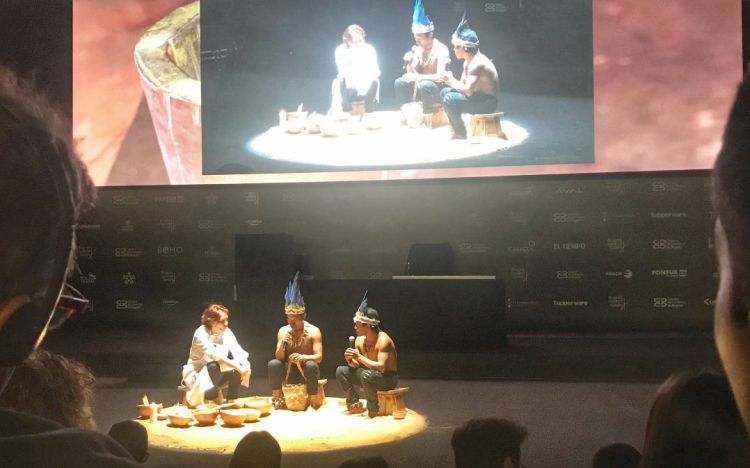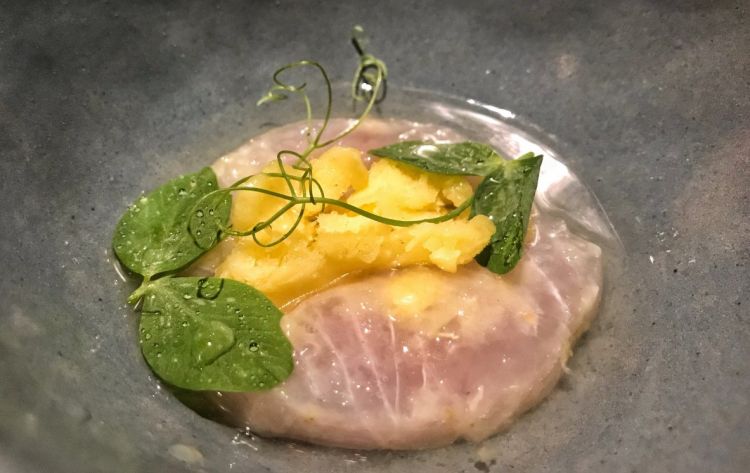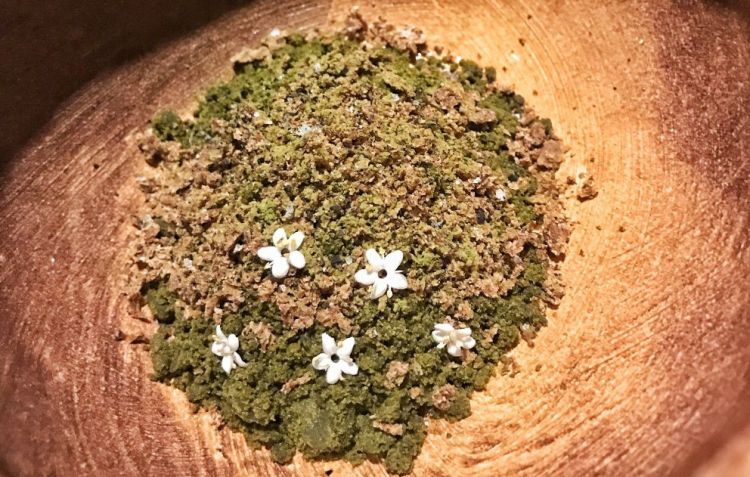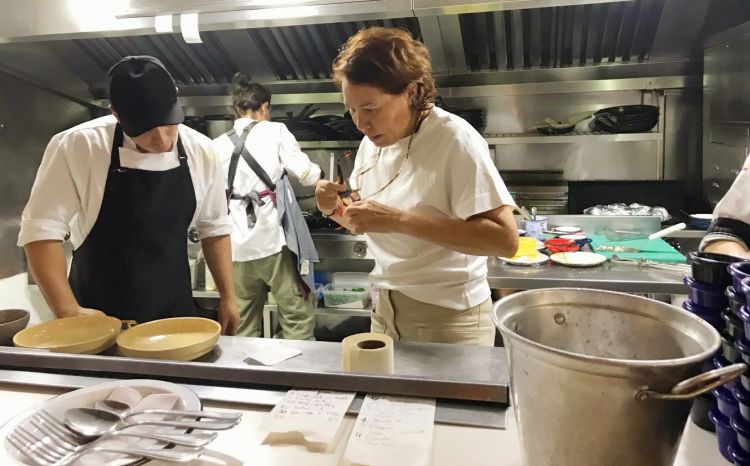The audience at the first edition of Bogotá Madrid Fusion (the Latin American spin-off of the Spanish Culinary Congress, which we presented in this article) was the kind that doesn’t miss the big occasions. Indeed this was the case for the last “ponencia”, at the end of two days full of interesting content and great chefs, local and (mostly) not. It was handed, of course, to the most famous Colombian chef in the world.
Leonor Espinosa conquered lots of interest internationally when, in July 2017, she won the Basque Culinary World Prize for her commitment in promoting the valuable local biodiversity, thanks especially to her work at her Funleo foundation. Espinosa, moreover, with her restaurant Leo in Bogotá is the only Colombian in the World’s 50 Best Restaurants, at number 49.

A photo from the lesson of Leonor Espinosa at Bogotá Madrid Fusion
Her talk was much awaited, also because those who know Leonor Espinosa know she loves to unsettle, to use occasions like this one to convey some strong messages. And indeed this was the case. After being presented, Espinosa left the stage, which remained completely empty, without the necessary tools for the cooking demo, as usually the case during the lessons of a culinary congress.
Instead, she prepared and organised another space in front of the stage. A circle on the floor, on which two natives from the Amazon forest sat, wearing their traditional clothes. Around them, rudimental containers, from which the two people who belong to the Huitoto community started to take the ingredients to prepare a Mambe, that is to say a powder made with coca leaves, mixed with yarumo leaves (another tree that grows in the Amazon forest) and juice of tobacco leaves.
Leonor Espinosa left the entire scene to the two natives for a few minutes, and then sat beside them, without ever speaking. The two of them instead spoke in turn, partly to explain in Spanish what they were doing, and the spiritual value of their gestures and of the ingredients they were using, partly in the Huitoto language, to complete a sacred ceremony.
As they explained themselves, their approach to food is certainly different to what we are used to in our contemporary urban cultures. «Food is nourishment both for the body and for the soul – they said during what became “their” lesson – this is why we consider food as a medicine, rather than simple ingredients in a recipe».

Fish from the Pacific coast, copoazù, guesguin
It was definitely a different lesson compared to what normally happens at a chefs’ congress. So much so that some didn’t quite get the meaning of this choice by Espinosa: during the following press conference, for instance, a Mexican journalist asked her whether she didn’t think she had lost an opportunity to speak to the audience, especially to the many students coming from the country’s catering schools, and make her message clear and simple.
«Do you really believe I haven’t sent a clear message?», Espinosa asked in return. «I believe I have, and I’ve been truthful to myself. I’m not just a cook, but I have an artistic background and today I created a performance. Taking a step back, putting the ego aside, something that too many chefs consider the most important thing of all. We have plenty to learn, we must be ready to listen to those who, like the native Huitotos, can show us a different sensitivity and history from our own. Those who want to find out about me and my cuisine, have hundreds of online articles to start from. For me today it was important to give space to those who for years have taught me their culture».

Mambe with powdered mojojoy larvas
A clear and strong message. Which she also passes in the culinary offer at Leo, her main restaurant inBogotá, which she runs with her daughter and sommelier Laura, very good both in running the dining room with precision and warmth, and in presenting pairings that are everything but ordinary, at least for European palates.
Leo is the gourmet restaurant in which the personality of the chef can be perceived in every dish, but in which techniques never prevail. It’s the ingredients, the result of a constant research, that guide Leonor Espinosa, whose main goal is to illustrate the richness and biodiversity of her country. There’s lots of Amazon forest, there’s the Caribbean coast with its Afro-Arab influences, and the Pacific coast.
Indeed, the tasting menu at
Leo is presented (at the end of the journey, not to ruin the surprise) in the shape of a map, so that guests can find the path they’ve followed, dish after dish. This menu is called “Ciclo-Bioma” and it’s the result of a constant study of the Colombian ecosystems, finding new ingredients both for cooking and for the pairing of wines and drinks (there’s a completely alcohol-free option too). Thanks to a sound relationship which she has created over many years with biologists, producers, farmers and native communities, this menu offers a very detailed picture of the flavours of a vast and complex country like Colombia, and a summary of ancestral knowledge.

Leonor Espinosa at work in the kitchen of Misia
And new discoveries too. Like the tongue of Pirarucù, a large fish that lives in the waters of the Amazon forest, and has been very appreciated for some time. But it was
Espinosa who first experimented the use of its tongue, which now has the main role in a delicious dish at her restaurant. In any case, for most people who approach the cuisine of
Espinosa virtually every tasting is a discovery: from the citrusy notes of the “limonere” ants, to the slightly earthy aroma of copoazù, an Amazon relative of cocoa, to the many other surprising flavours.
The offer at Misia, her second restaurant opened in the Colombian capital is more pop and somewhat richer. Here the cook focuses on the cuisine of the Caribbean coast, and thus on her origins, given she was born in Cartagena. So she delights her guests with dishes full of flavours, like the selection of fried food from the Caribbean Islands, the Ceviche cartagenero or the Posta negra, a beef stew considered the emblem-dish of the chef’s hometown.
Leonor Espinosa, whether with her original and effective lesson atBogotá Madrid Fusion, or with the concepts and research that with attention and passion she translates into the dishes at her two restaurants, confirms she’s the best ambassador of her country’s gastronomy.
Translated into English by Slawka G. Scarso